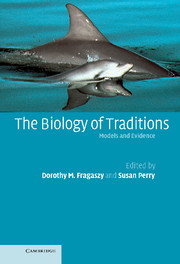Book contents
- Frontmatter
- Contents
- List of contributors
- Preface
- Acknowledgements
- 1 Towards a biology of traditions
- 2 What the models say about social learning
- 3 Relative brain size and the distribution of innovation and social learning across the nonhuman primates
- 4 Social learning about food in birds
- 5 The cue reliability approach to social transmission: designing tests for adaptive traditions
- 6 “Traditional” foraging behaviors of brown and black rats (Rattus norvegicus and Rattus rattus)
- 7 Food for thought: social learning about food in feeding capuchin monkeys
- 8 Traditions in mammalian and avian vocal communication
- 9 Like mother, like calf: the ontogeny of foraging traditions in wild Indian Ocean bottlenose dolphins (Tursiops sp.)
- 10 Biological and ecological foundations of primate behavioral tradition
- 11 Local traditions in orangutans and chimpanzees: social learning and social tolerance
- 12 Developmental perspectives on great ape traditions
- 13 Do brown capuchins socially learn foraging skills?
- 14 Traditions in wild white-faced capuchin monkeys
- 15 Conclusions and research agendas
- Further reading
- Index
- References
Preface
Published online by Cambridge University Press: 27 October 2009
- Frontmatter
- Contents
- List of contributors
- Preface
- Acknowledgements
- 1 Towards a biology of traditions
- 2 What the models say about social learning
- 3 Relative brain size and the distribution of innovation and social learning across the nonhuman primates
- 4 Social learning about food in birds
- 5 The cue reliability approach to social transmission: designing tests for adaptive traditions
- 6 “Traditional” foraging behaviors of brown and black rats (Rattus norvegicus and Rattus rattus)
- 7 Food for thought: social learning about food in feeding capuchin monkeys
- 8 Traditions in mammalian and avian vocal communication
- 9 Like mother, like calf: the ontogeny of foraging traditions in wild Indian Ocean bottlenose dolphins (Tursiops sp.)
- 10 Biological and ecological foundations of primate behavioral tradition
- 11 Local traditions in orangutans and chimpanzees: social learning and social tolerance
- 12 Developmental perspectives on great ape traditions
- 13 Do brown capuchins socially learn foraging skills?
- 14 Traditions in wild white-faced capuchin monkeys
- 15 Conclusions and research agendas
- Further reading
- Index
- References
Summary
For many decades, the scientific discussion about social learning in nonhuman animals has been dominated by two concerns: (1) whether any nonhuman species, but ape species in particular, possess “culture”, and (2) which nonhuman species exhibit imitation, assumed by many to be a prerequisite or at the least an important support for culture. However, from a biological point of view, these questions only narrowly address fundamental issues about social learning in nonhuman animals. Their link to functional, developmental, and evolutionary questions is not obvious, for example. We wanted to know about these latter topics, as well as more broadly about mechanisms supporting social learning, so we set about asking our colleagues what they thought. We got many answers that we felt were worthy of better dissemination than they were receiving in the literature or in the classroom. This book is the result.
This book is intended for individuals interested in understanding social learning (the common short-hand phrase for what is more precisely called socially aided learning) in animals from a biological perspective. We focus on one outcome of social learning, traditions, as an element in behavioral ecology. By tradition, we mean a distinctive behavior pattern shared by two or more individuals in a social unit, which persists over time and that new practitioners acquire in part through socially aided learning. The process of social learning does not lead inevitably to enduring traditions, however.
- Type
- Chapter
- Information
- The Biology of TraditionsModels and Evidence, pp. xiii - xviPublisher: Cambridge University PressPrint publication year: 2003
References
- 4
- Cited by

